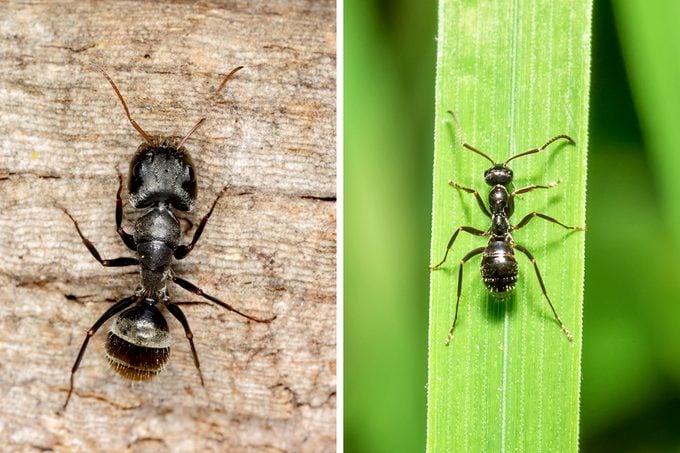 Getty Images (2)
Getty Images (2)
If you’ve ever seen the damage carpenter ants can do, you understand why it’s so important to control them.
My housemate used to see them regularly emerge from the wood slat ceiling of her bedroom during the summer. She tried fogging the room with cedar oil, spraying the ants with insecticides and sealing gaps. When we removed part of the roof to fix a leak, we were shocked to discover the ants were the cause — they ate through the decking.
Not all carpenter ants (Camponotus spp.) are black. But the two species you’re most likely to find in North America — the Eastern carpenter ant (Camponotus pennsylvanicus) and the Western one (Camponotus modoc) — are mostly black, and they’re hard to miss. C. pennsylvanicus is so noticeable it was the first named North American ant species.
The carpenter ant isn’t the only black kind, of course. Carpenter ants are often confused with the black garden ant, aka the common black ant (Lasius niger). A few dead giveaways make it easy to distinguish other black ants from carpenter ants.
Carpenter Ants vs. Black Ants: What Do They Look Like?
Let’s start with size, because that’s the most noticeable difference. Compared to the others, carpenter ants are huge, reaching lengths between 1/2-in. and 5/8-inches. The largest competitor, the common black ant, is about half that size. Common black ant queens can grow to 1/3-in., but you’ll seldom see one.
If you zero in on physical characteristics, you’ll find carpenter ants have triangular heads instead of the rounded ones of other species. Their antennae are bent instead of straight. And the petiole, which connects the chest to the abdomen, is singular; other ants have two distinct sections. And carpenter ants grow wings during the mating season, which other black ants don’t.
It’s more common to confuse carpenter ants with termites. Both bore into wood, though termites actually eat it, while carpenter ants remove it to make nests. Both grow wings, and they’re almost the same size. Termites, however, are brown, not black, and don’t have segmented bodies like ants.
Carpenter Ants vs. Black Ants: Where Do They Live?
Carpenter ants like soft, wet wood. That’s where the “carpenter” comes from. They burrow intricate tunnels by chewing through the wood and leaving the residue behind as sand-sized particles.
Any structure with a wooden frame is a potential home for carpenter ants, especially one with a moisture problem. If that’s your home, you may notice sawdust piles on your floors or windowsills underneath their colonies. If left untreated long enough, carpenter ants can weaken the framing and necessitate expensive repairs.
No other species of black ant lives like this. Most others prefer to live outdoors in mounds; under logs, rocks or pavement; and in vegetation. Common black ants are known as garden ants because they like to live close to aphids, which excrete their favorite sweet food — honeydew.
Carpenter Ants vs. Black Ants: Behavioral Differences
When any ants enter your home, it’s usually because they’ve discovered food. Black ants form trails between food sources and their colony. Occasionally they’ll establish a colony in the walls of the building, but usually it’s outside. If you have houseplants, they may be found underneath pots or containers, especially if you have aphids under the leaves.
Carpenter ants, on the other hand, spend their time burrowing into the framing. You may see a few emerging from a crack in the wall. When you do, you know you have an infestation. There will be hundreds more you can’t see in the rafters, wall framing or floor joists.
They don’t form trails, although many may congregate around a food source at once. They can travel up to 300 feet from their nest. They’re most active from just before dusk until dawn.
Carpenter Ants vs. Black Ants: How To Get Rid of Them
Baiting is one of the most effective ways to get rid of ants. The bait mixes a poison like boric acid with a sweet food like honey, or an oily one like peanut butter, in the proper proportion. The ants bring the bait back to colony, and they all eat it and die.
Because carpenter ants are bigger than other types of black ants, it requires more poison to kill them. So it’s important to positively identify the ants so you can buy the right bait.
There are two potential problems with baiting, though. Some species of black ants form several colonies, and eliminating just one won’t stop an infestation. And carpenter ants can be finicky and cycle between sweet and oily foods. So you may have to use another strategy.
Following an ant trail to the wall where they emerged, then dusting behind the wall with boric acid or diatomaceous earth, can effectively kill them and divert their trail.
You can also spray the ants you see, and spray behind the wall to kill the ones you don’t. For this, we’ve found Orange Guard to be effective and safe enough to use around food. However, you probably won’t get all of them this way, especially if they’re carpenter ants burrowed deep into the framing. In the end, you may be better off hiring an exterminator.
ⓘ





















